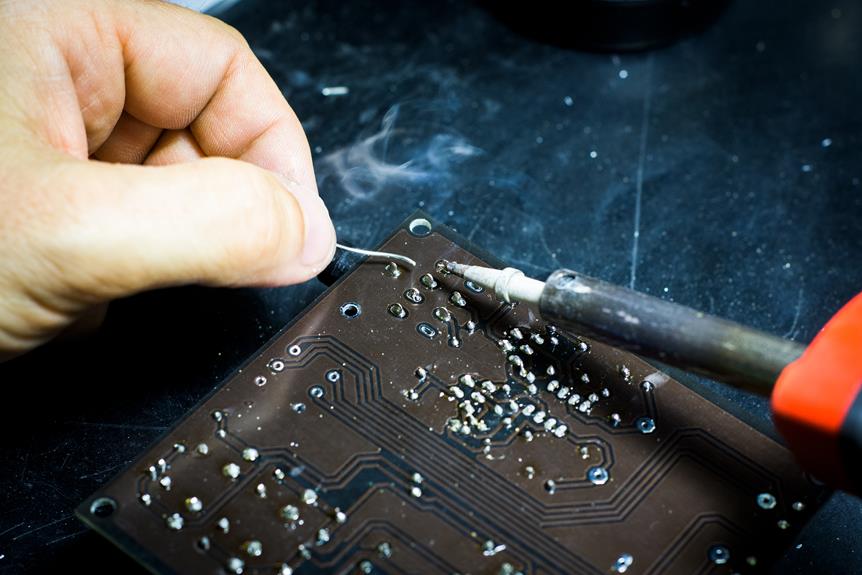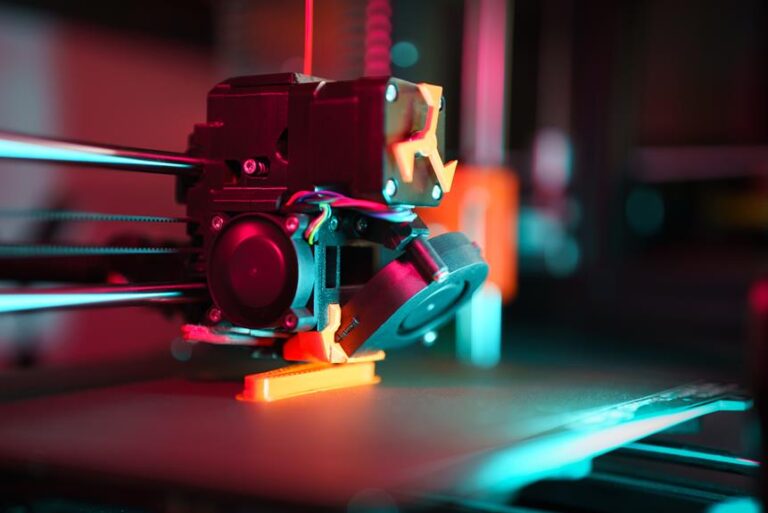3D Printing in Electronics Manufacturing: Opportunities and Challenges
In the realm of electronics manufacturing, the advent of 3D printing has presented both promising opportunities and complex challenges.
This article delves into the role of 3D printing in this industry, exploring its advantages, potential impact on design, and the customization potential it offers.
Additionally, it analyzes the integration of 3D printing into the electronics supply chain, providing a future outlook and showcasing real-world successes through case studies.
Join us as we navigate the technical intricacies and liberation possibilities of 3D printing in electronics manufacturing.
Key Takeaways
- 3D printing in electronics manufacturing enables the creation of complex geometries and smaller, lighter components.
- It offers cost savings through reduced material waste and the elimination of tooling costs.
- 3D printing allows for design flexibility, customization, and rapid prototyping, enabling quick testing and refinement of ideas.
- Integration of 3D printing in the electronics supply chain can lead to on-demand manufacturing, reduced inventory costs, and localized production.
The Role of 3D Printing in Electronics Manufacturing
The role of 3D printing in electronics manufacturing has been a subject of great interest and exploration in recent years. This technology offers numerous opportunities for innovation and efficiency in the production of electronic devices.
One of the key advantages of 3D printing in electronics manufacturing is the ability to create complex geometries that are difficult or impossible to achieve with traditional manufacturing techniques. This allows for the development of smaller, lighter, and more functional electronic components.
Additionally, 3D printing enables the use of advanced materials that possess unique properties, such as enhanced conductivity or heat resistance. By incorporating these materials into the manufacturing process, electronic devices can be optimized for improved performance and durability.
Furthermore, the integration of artificial intelligence (AI) and machine learning in 3D printing can enhance the manufacturing process by optimizing designs and improving efficiency. These technologies can analyze data and make real-time adjustments to printing parameters, resulting in higher quality products and reduced production time.
However, despite the numerous benefits, there are also challenges associated with the adoption of 3D printing in electronics manufacturing. These include the need for further research and development to optimize the printing process, the high cost of 3D printing equipment and materials, and the requirement for skilled personnel to operate and maintain the technology.
Nonetheless, with continued advancements and investment in this field, the role of 3D printing in electronics manufacturing is expected to expand, revolutionizing the industry and unlocking new possibilities for design and production.
Advantages of 3D Printing in Electronics Production
The advantages of 3D printing in electronics production are numerous.
One key advantage is the potential for cost savings in production. By using 3D printing technology, manufacturers can reduce material waste and eliminate the need for expensive molds or tooling.
Additionally, 3D printing offers design flexibility and customization options that traditional manufacturing methods cannot match, allowing for more intricate and personalized electronic components.
Cost Savings in Production
While 3D printing offers several advantages in electronics production, one of the most significant benefits is the potential for cost savings. This can be attributed to several factors:
- Reduced material waste: 3D printing allows for precise deposition of materials, minimizing waste compared to traditional manufacturing methods.
- Elimination of tooling costs: Traditional manufacturing typically requires the creation of molds, dies, or other tools, which can be expensive. With 3D printing, these costs are eliminated as parts can be directly printed from a digital file.
- Streamlined production processes: 3D printing enables the consolidation of multiple components into a single printed piece, reducing assembly time and labor costs.
By leveraging these cost-saving advantages, companies can achieve significant reductions in production costs, making 3D printing an attractive option for electronics manufacturing.
Furthermore, these cost savings can be reinvested in research and development, enabling greater innovation and product improvement.
In the next section, we will explore how 3D printing also offers unparalleled design flexibility and customization opportunities.
Design Flexibility and Customization
Design flexibility and customization are key advantages that 3D printing brings to the field of electronics production. With traditional manufacturing methods, design changes often require expensive tooling modifications and lengthy production cycles. However, 3D printing allows for rapid prototyping and iteration, enabling designers to quickly test and refine their ideas. Additionally, 3D printing enables the creation of complex geometries and intricate designs that would be difficult or impossible to achieve with traditional manufacturing techniques. This level of design freedom allows for the customization of electronic products to meet specific customer requirements. For example, a consumer electronics company could easily personalize the appearance of their products or tailor the functionality to individual users. The following table highlights the advantages of design flexibility and customization in 3D printing for electronics production:
| Advantages of Design Flexibility and Customization in 3D Printing |
|---|
| Rapid prototyping and iteration |
| Creation of complex geometries and intricate designs |
| Customization of electronic products |
Challenges in Implementing 3D Printing in Electronics Manufacturing
Facing the complexities of integrating additive manufacturing techniques into the established processes of electronics manufacturing presents significant hurdles for industry professionals. As 3D printing continues to advance, there are several challenges that need to be addressed in order to fully implement this technology in the electronics manufacturing sector.
These challenges include:
- Material selection: The range of materials suitable for 3D printing in electronics manufacturing is limited compared to traditional manufacturing methods. Finding materials that possess the necessary properties, such as conductivity, heat resistance, and durability, is crucial for the successful integration of 3D printing.
- Process optimization: Optimizing the 3D printing process for electronics manufacturing is essential to ensure consistent and reliable production. This involves understanding the interaction between the printing parameters, material properties, and the desired electronic components. Fine-tuning the process parameters and optimizing the printing techniques are necessary to achieve high-quality and functional electronic devices.
- Quality control and testing: Implementing 3D printing in electronics manufacturing requires developing reliable quality control and testing methods. Ensuring the integrity and functionality of printed electronic components is crucial to meet industry standards and customer expectations. Developing non-destructive testing techniques and implementing rigorous quality control processes are essential to guarantee the reliability and performance of 3D printed electronics.
Overcoming these challenges will enable the widespread adoption of 3D printing in electronics manufacturing, unlocking its potential for increased design flexibility, customization, and faster prototyping. Industry professionals need to collaborate and invest in research and development to address these challenges and fully harness the benefits of 3D printing in the electronics sector.
Impact of 3D Printing on Electronics Design
With the increasing adoption of 3D printing in electronics manufacturing, there are notable changes in the way electronic products are designed and developed. 3D printing, also known as additive manufacturing, offers significant advantages in terms of design flexibility, customization, and rapid prototyping. This technology allows designers to create complex and intricate structures that were previously difficult or impossible to produce using traditional manufacturing methods.
One of the key impacts of 3D printing on electronics design is the ability to integrate multiple components into a single printed object. This eliminates the need for assembly and reduces the overall size and weight of electronic devices. Additionally, 3D printing enables the creation of customized designs tailored to specific applications or user requirements. This level of customization was not feasible with traditional manufacturing techniques, which often required expensive tooling and long lead times.
Moreover, 3D printing enables the production of complex geometries and internal features that were challenging to achieve previously. This opens up new possibilities for the design of electronic devices, such as improved heat dissipation, enhanced structural integrity, and reduced material waste.
However, there are also challenges associated with the integration of 3D printing into electronics design. Ensuring the compatibility of printed components with existing manufacturing processes and materials is one such challenge. Additionally, the reliability and performance of 3D printed electronic components need to be thoroughly tested and validated before they can be widely adopted.
Prototyping With 3D Printing in Electronics Industry
Prototyping plays a crucial role in the electronics industry as it allows for the testing and validation of new designs before mass production.
3D printing has emerged as a cost-effective solution for prototyping, enabling manufacturers to quickly iterate and refine their designs.
Cost-Effectiveness of Prototyping
While there are several challenges associated with the cost-effectiveness of prototyping in the electronics industry, 3D printing offers promising opportunities to overcome them. Here are three key ways that 3D printing can enhance the cost-effectiveness of prototyping:
- Reduced material waste: Traditional prototyping methods often require a significant amount of material to be used, resulting in a high level of waste. With 3D printing, materials can be used more efficiently, minimizing waste and reducing costs.
- Faster iteration cycles: 3D printing enables rapid prototyping, allowing for faster iteration cycles. This means that design changes and improvements can be made more quickly, reducing the time and cost associated with multiple iterations.
- Customizability: 3D printing allows for greater customization in prototyping, enabling designers to create complex and intricate designs that would be difficult or costly to achieve with traditional methods. This flexibility can lead to cost savings by eliminating the need for additional manufacturing processes.
By leveraging these advantages, 3D printing can significantly improve the cost-effectiveness of prototyping in the electronics industry.
Transitioning into the next section, we will now explore how 3D printing can also speed up product development.
Speeding up Product Development
To expedite product development in the electronics industry, 3D printing offers a solution by enabling rapid prototyping and reducing time-to-market. By utilizing 3D printing technology, manufacturers can quickly create physical prototypes of electronic components and devices, allowing for accelerated testing and validation processes. This enables engineers to identify and rectify design flaws early in the development cycle, ultimately saving time and resources.
Additionally, 3D printing allows for the production of complex geometries and intricate designs that would be challenging or time-consuming to manufacture using traditional methods. The ability to rapidly iterate and refine prototypes using 3D printing enhances the overall efficiency of product development in the electronics industry.
As we delve into the customization potential of 3D printing in electronics manufacturing, it becomes evident how this technology can revolutionize the industry.
Customization Potential of 3D Printing in Electronics Manufacturing
The customization potential of 3D printing in electronics manufacturing offers a unique opportunity for companies to meet specific customer requirements and create personalized products. This technology allows for the creation of highly customized electronic devices, components, and prototypes, enabling companies to cater to the individual needs and preferences of their customers.
Here are three key aspects that highlight the customization potential of 3D printing in electronics manufacturing:
- Design flexibility: 3D printing enables the production of complex and intricate designs that would be difficult or impossible to achieve using traditional manufacturing methods. This allows for the creation of unique and customized electronic products, tailored to specific customer requirements.
- Rapid prototyping: With 3D printing, companies can quickly and cost-effectively produce prototypes of new electronic products or components. This enables them to test and iterate designs, ensuring that the final product meets the exact specifications and preferences of their customers.
- Mass customization: 3D printing offers the possibility of mass customization, where each product can be individually customized during the manufacturing process. This allows companies to efficiently produce variations of a product to meet different customer preferences, without the need for complex and costly production setups.
The customization potential of 3D printing in electronics manufacturing empowers companies to offer highly personalized products to their customers, enhancing customer satisfaction and creating a competitive advantage in the market.
Integration of 3D Printing in Electronics Supply Chain
An important aspect of the adoption of 3D printing in electronics manufacturing is the integration of this technology into the supply chain. The integration of 3D printing can revolutionize the electronics supply chain by enabling on-demand manufacturing and reducing lead times.
Traditionally, the electronics supply chain involves multiple stages, including design, prototyping, production, and distribution. Each stage requires coordination among various stakeholders, including designers, manufacturers, and distributors.
By integrating 3D printing, the supply chain can become more agile and responsive to dynamic market demands. With 3D printing, manufacturers can produce electronic components and parts on-site, eliminating the need for lengthy production cycles and transportation delays. This can significantly reduce lead times and enable just-in-time manufacturing, leading to cost savings and improved efficiency.
Furthermore, 3D printing allows for greater design flexibility and customization. Manufacturers can quickly iterate and test designs, reducing the time and cost associated with traditional prototyping methods. This flexibility enables the development of innovative products and the ability to respond quickly to changing customer requirements.
However, the integration of 3D printing into the electronics supply chain also presents challenges. The technology requires skilled operators and specialized equipment, which may require additional training and investment. Additionally, the quality and performance of 3D-printed components must meet industry standards and regulations. Therefore, proper quality control and testing processes must be implemented to ensure the reliability and safety of the printed electronics.
Future Outlook for 3D Printing in Electronics Manufacturing
One potential area of growth for 3D printing in electronics manufacturing is the development of new materials and processes. As technology continues to advance, researchers and manufacturers are constantly exploring ways to enhance the capabilities of 3D printing in the electronics industry.
Here are three key areas that hold promise for the future of 3D printing in electronics manufacturing:
- Material Innovation: The development of new materials specifically designed for 3D printing in electronics manufacturing is crucial for achieving high-performance electronic devices. Researchers are working on creating conductive inks, polymers, and composites that offer improved electrical and mechanical properties, enabling the production of more complex and functional electronic components.
- Multi-material Printing: The ability to print multiple materials simultaneously is essential for creating intricate electronic devices. Advancements in multi-material 3D printing technologies will enable the fabrication of circuits, sensors, and other electronic components with varying properties, further expanding the range of applications for 3D printing in electronics manufacturing.
- Integrated Electronics Printing: Integrating electronic components directly into the 3D printing process can streamline production and reduce assembly costs. This approach involves printing conductive traces, sensors, and other electronic elements onto the substrate or embedding them within the structure, eliminating the need for separate assembly steps. Continued research in this area will lead to more efficient and cost-effective manufacturing processes.
These advancements in materials, multi-material printing, and integrated electronics printing hold great potential for the future of 3D printing in electronics manufacturing. As these technologies continue to evolve, we can expect to see increased adoption of 3D printing in various industries, enabling the production of highly customized, functional, and efficient electronic devices.
Case Studies: Successful Applications of 3D Printing in Electronics
In recent years, numerous successful applications of 3D printing in electronics have demonstrated the transformative potential of this technology in the manufacturing industry. One notable case study is the production of customized electronic components using 3D printing. Companies are now able to create intricate and complex designs that were previously impossible with traditional manufacturing methods. This has led to increased efficiency in the production process and reduced costs.
Another successful application of 3D printing in electronics is the creation of flexible electronic devices. Traditional manufacturing techniques often struggle to produce flexible electronics due to the limitations of rigid molds. However, with 3D printing, companies can now create flexible circuits and sensors that can be integrated into various products, such as wearables and medical devices.
Furthermore, 3D printing has also been used to create prototypes and small-scale production runs of electronic devices. This allows companies to quickly iterate and test their designs before committing to large-scale production. It also reduces the time and cost associated with traditional prototyping methods.
Frequently Asked Questions
How Does 3D Printing Technology Work in the Context of Electronics Manufacturing?
3D printing technology in electronics manufacturing involves creating three-dimensional objects by layering materials based on a digital design. It offers opportunities for faster prototyping, customization, and cost reduction, but also presents challenges related to material selection, precision, and scalability.
What Are the Potential Cost Savings Associated With Implementing 3D Printing in Electronics Production?
The potential cost savings associated with implementing 3D printing in electronics production are significant. By eliminating the need for traditional manufacturing processes and reducing material waste, companies can streamline their operations and reduce production costs, resulting in higher profitability.
What Are the Major Obstacles That Companies Face When Trying to Adopt 3D Printing in Electronics Manufacturing?
The major obstacles that companies face when trying to adopt 3D printing in electronics manufacturing include technological limitations, high initial costs, regulatory compliance, lack of skilled workforce, and the need for optimized design and material selection.
How Does 3D Printing Impact the Design Process of Electronic Products?
The impact of 3D printing on the design process of electronic products is significant. It allows for more complex and intricate designs, faster prototyping, and customization options. However, it also presents challenges in terms of material compatibility and production scalability.
Can You Provide Examples of Real-World Applications Where 3D Printing Has Been Successfully Used in the Electronics Industry?
Numerous real-world examples demonstrate the successful use of 3D printing in the electronics industry. These applications range from prototyping and customization of electronic components to the production of complex circuitry and wearable devices, showcasing the versatility and potential of this technology.
Conclusion
In conclusion, 3D printing has emerged as a promising technology in the field of electronics manufacturing. It offers numerous advantages such as rapid prototyping, customization potential, and integration into the supply chain.
However, there are challenges that need to be addressed, including the high cost of equipment and materials, as well as the need for further research and development.
Despite these challenges, the future outlook for 3D printing in electronics manufacturing is promising, with an estimated market size of $8.2 billion by 2025.









